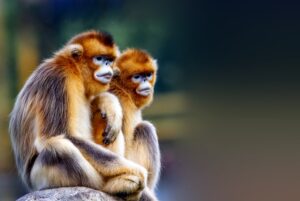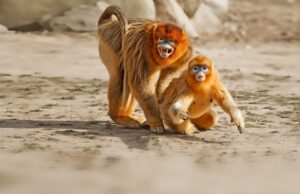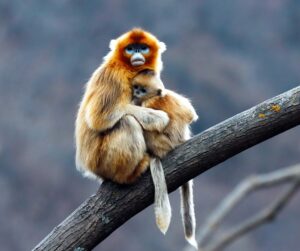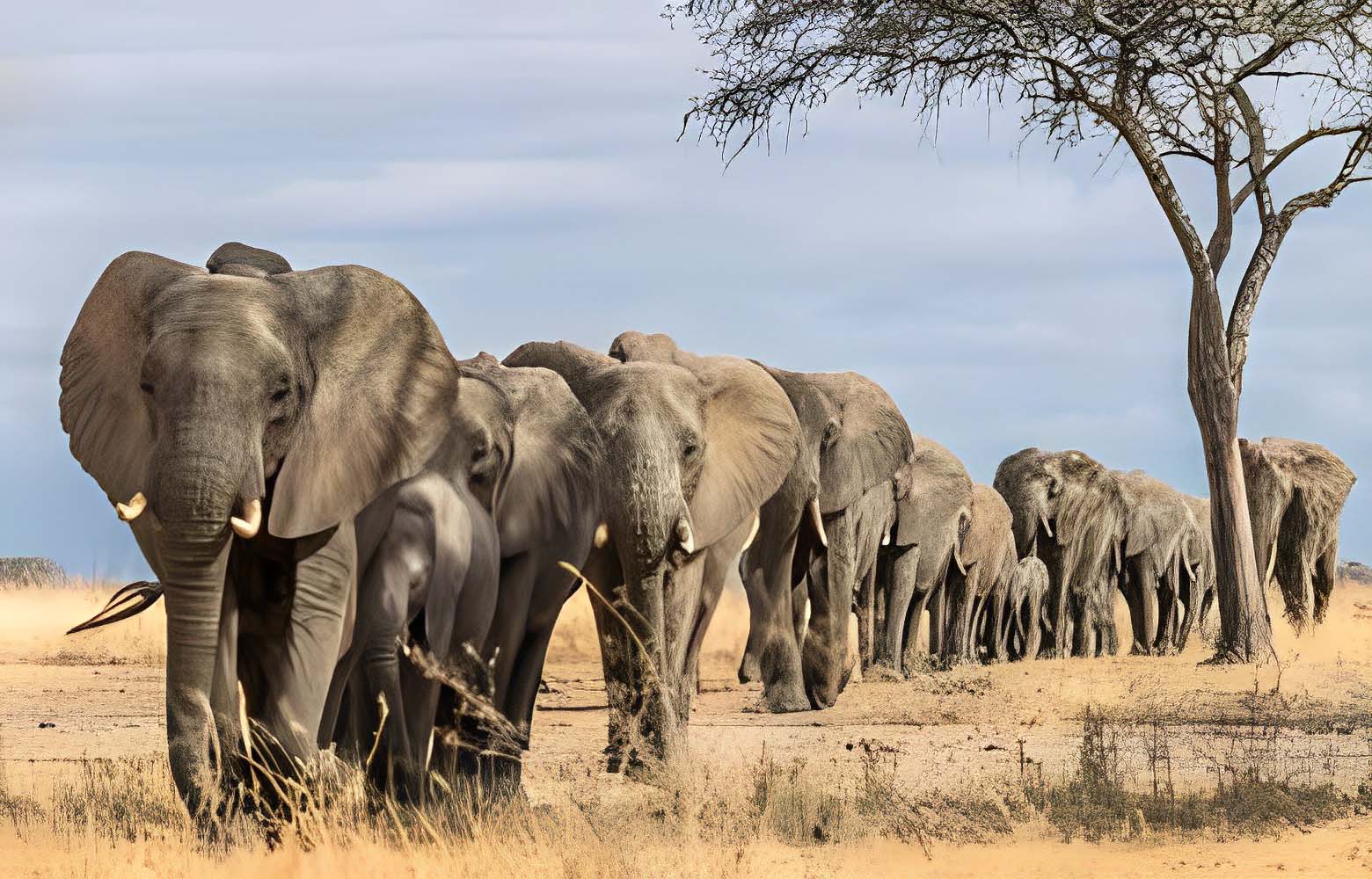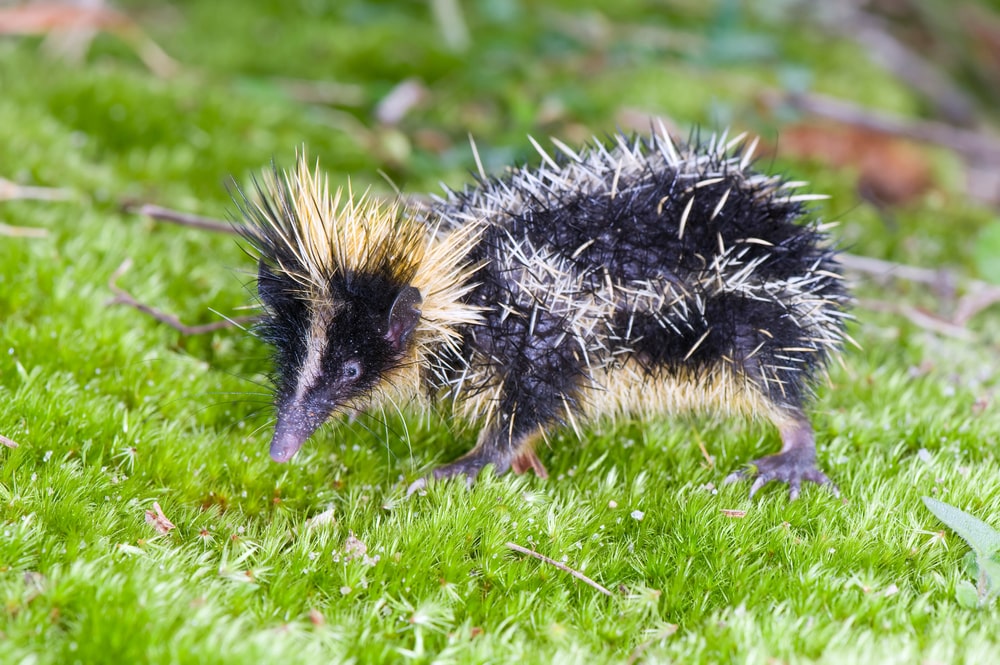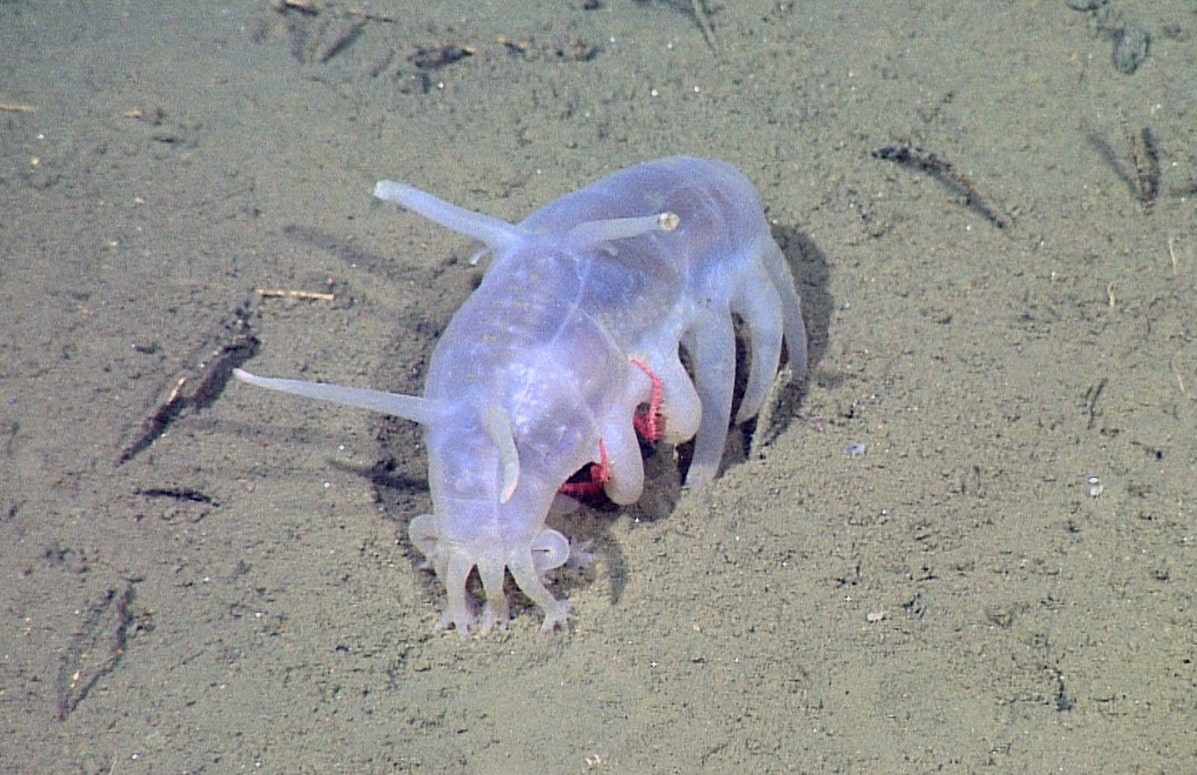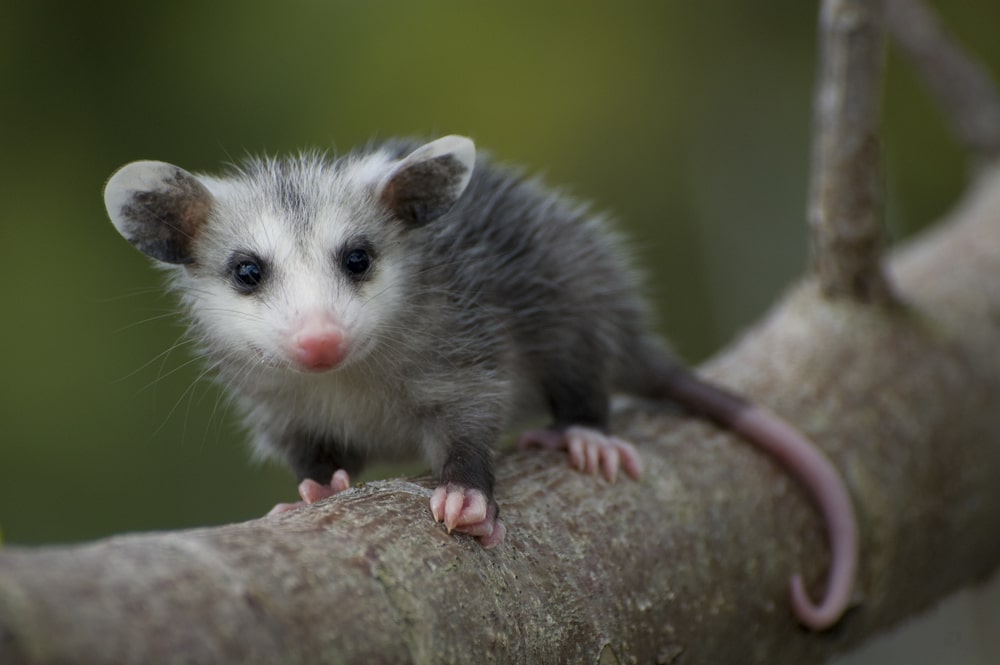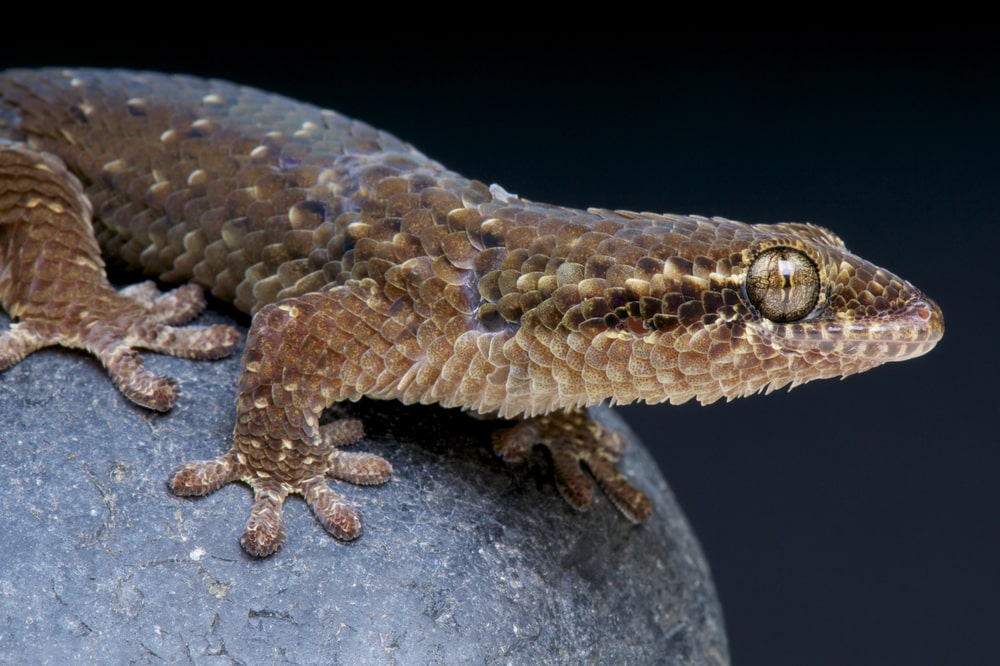Sneezing monkey, the Bizarre Golden snub-nosed Primates
Sneezing monkey: You might never have expected a primate to feature on this list given the fact that most of the creatures so far have been incredibly alien in their design, but the sneezing monkey certainly questions many of the shared traits often found in our ape-like cousins, otherwise known as Myanmar snub-nosed monkeys.
Sneezing monkey
This bizarre primate was originally discovered in 2010 in northern Myanmar but has recently become critically endangered and threatened by extinction. Although their appearance and behavior are rarer, the sneezing monkeys have wide, upturned nostrils that bizarrely fill with water when it rains.
As the locals of northern Myanmar described during the rainy season, these snub-nosed monkeys can be heard hiding in the treetops, sneezing repeatedly as their nasal passages fill with water. No one knows exactly how or why these creatures evolved in the unique way that they did, and sadly, unless their conservation status improves, we may never know.
Which endangered animals is your organization currently looking for or monitoring? Are you asking only endangered animals or are you asking for threatened wildlife species? I assume you are asking for threatened wildlife species. In the Myanmar program, we are working for the conservation of the tiger, elephant, myanmar snub-nosed monkey.
Three species of hoalick gibbons: western hoalick gibbon, eastern hawali gibbon, and skywalker hoalick gibbon hog deer; two vulture species: dumped vulture and slender build vulture; and Sarah’s crane. What plans, projects, and common policies are currently being taken on to help these endangered creatures? Myanmar snub-nosed monkey community-based conservation in Imabom area since 2010 distribution and population study Imabam national park was designated in March 2020 for protection of this species.
What are your insights on the endangerment among Burmese animals? Explain your awareness about the endangered Burmese animal. Poverty is the main cause of threatening all wildlife in Myanmar. It is required that policymakers, authorities, communities, and technicians work together to protect wildlife species. How do you feel about people’s ignorance of these endangered species? I can understand that only a few people in Myanmar were taught to love animals and to value nature.
How do you want Burmese citizens to act out for the sake of these species to understand the ecosystem services and value of biodiversity? any picture videos, newspaper articles to prove this rare peacock turtle rescued and released in Myanmar fauna and flora international.
The Golden Monkey
This is a story about an incredible primate. Highly sociable, extremely affectionate, and very vocal. The golden snub-nosed monkey. Its home is China’s remote mountain forests. China is a realm of diverse landscapes. full of rare and surprising creatures. For the first time, we’ll uncover their remarkable, untold stories in The Hidden Kingdoms of China. Golden Snubnosed Monkey A newborn golden snub-nosed monkey. She’s just a few hours old and entirely dependent on her mother.
In the year ahead, she’ll be at her most vulnerable and will face many challenges. She’ll need intelligence, strength, and, most of all, her family’s care and love. if she’s to survive in China’s mountain forest kingdom. The endangered golden snub-nosed monkey lives only in the high mountain forests of central China. Up to 13,000 feet above sea level. Our baby girl’s troop lives in the world’s largest high-altitude forest, where there are more tree species than in any other deciduous forest on Earth Spring It’s spring.
And the monkeys are in high spirits. The troop has five families. Each with one male, several females, and their young. Males that aren’t part of the family live in the troop’s bachelor gang. They’re a boisterous bunch, but right now, they’re not the center of attention. That honor belongs to our baby girl. She’s the firstborn this spring, and the females in the family will do anything to get a cuddle. This auntie is first in line.
But not for long With only one baby to go around, Competition is fierce When it all gets a bit too much, it’s mom to the rescue. The monkeys’ attention soon turns to their tummies. In spring, they spend a quarter of the daylight hours eating fresh, new leaves. Their favorite food is an important source of protein. Streams As temperatures rise, trees higher up the mountain spring to life.
And the monkeys follow the feast. Crystal clear streams run through these high forest valleys. The surrounding trees filter the rain, and their shade keeps the water cool helping to maintain the healthy grade levels of dissolved oxygen. These pristine streams are a lifeline. And not just for the monkeys. Giant Salamander One of China’s strangest creatures lives here. The Chinese giant salamander has hardly changed since the Jurassic period, over 170 million years ago.
Growing up to 6 feet long, it’s the largest amphibian in the world. This female has tiny eyes and poor vision, relying instead on smell and touch. and sensing vibrations to get around. She spends most of her life underwater, absorbing oxygen through her skin. Folds increase the surface area, maximizing the process. Although revered for centuries in China, illegal hunting and habitat destruction have left These creatures are critically endangered in the wild.
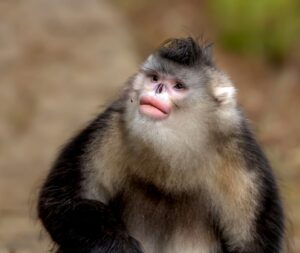
Black snub-nose monkey
For the few who remain, remote forest streams like this are a vital refuge. Baby Monkey Our baby girl is now three weeks old and exploring her forest home. She soon discovers that she shares it with other creatures. But it’s the family’s playful youngsters that really catch her eye. A year or two older than her, their lives seem like one endless play session. And she’s eager to try out some of the skills they’ve mastered. Hanging from one arm is best done close to the ground to begin with. Walking along a branch looks easy, but for our baby, it takes concentration. bravery, and brain power.
She’s figuring out how to turn around. and get back to mom. A moment of comfort… before the next adventure. Babies learn very quickly. And soon, she’s climbing trees. By following her instincts and imitating others, she’s grasping essential monkey skills. Spring is when all the new babies are born. It offers them the best chance of survival, as they’ll have the warmer months to grow strong. But in this high mountain forest, nothing is guaranteed.
Baby Death Spring weather can change in an instant. A sudden drop in temperature threatens all the troop’s babies. In China’s high mountain forests, spring rain brings a sudden drop in temperature. Our baby girl doesn’t yet have a full coat to protect her from the cold and wet. Alone in the treetops, she’s vulnerable to hypothermia. Her mom and family step in to keep her warm and dry. But as the weather worsens, rain turns to snow.
Disaster strikes the family. A mother cradles the lifeless body of her newborn baby. Her maternal instinct is so strong that she cares for her infant as though it’s still alive. Family members try to comfort her. But she seeks solitude. These monkeys seem to understand death, and this mother isn’t ready to let go. The sunshine returns, and life flourishes once more in the mountain forests. In time, spring turns to summer. Trees are in full bloom, and food is plentiful.
This area has more than 4,000 plant species, making these forests among the most biologically diverse on Earth. With food in such easy reach, there’s plenty of time for other activities. such as grooming. An all-important part of monkey society. It keeps skin and fur clean. But more importantly, it builds and cements relationships. And it’s just so relaxing. Naptime soon follows. Our baby girl doesn’t doze for long. At three months old, with stronger muscles and hand-eye coordination, She’s coming on leaps and bounds.
And she’s taking a big step in her social development. Playing with other babies. But at this age, she’s soon distracted and wanders off exploring. As the adults doze in the afternoon sun, Snake Attack A cold-blooded killer is waking up. And our baby girl has caught his attention. A king rat snake is heading towards our baby girl. This constrictor eats any creature it can wrap itself around. The alarm is raised. Many pairs of eyes help keep the monkeys safe the troop moves on.
Golden snub-nosed monkey
In this complex society, these intelligent monkeys use many different vocalizations. As the families and bachelor gang travel together, contact calls keep them all in touch. Individuals have their own unique signature calls. Particularly useful in dense vegetation when they can’t see each other well. They have lots to talk about in their ever-changing world. And the seasons are turning once more. Fall is arriving.
One of the best times of the year to see it. At six months old, our baby girl still depends on mom’s milk. But she’s also developing a taste for new things. She takes her most memorable chomp of strong food. She tries her hand at grooming. And she spends more time than ever playing. Ten times more than she did in the summer. Playing is fun, but it’s important, too. It keeps the monkeys fit and strong. enhances their social skills and sharpens their brains.
As long as they get the landing right. In Chinese folklore, monkeys represent rebellion and mischief. One group that lives up to that reputation is the troop’s bachelor gang. These young males were evicted from their families before they turned three. They wrestle endlessly, preparing for the day. They’ll fight to try to win their own family. One of the older bachelors has reached that point.
Aged seven, the warts on his lips show that he’s sexually mature. Apparently, these warts are attractive to females. He’ll win the right to mate if he can take over a family. He’s going to try to overthrow our baby girl’s dad. Dad and his family are under threat. Males who take over have been known to kill babies so they can sire their own posterity. Our baby girl could be in grave danger. A challenger is battling our baby girl’s dad, hoping to take over his family.
If he wins, he could kill her. Dad’s an experienced fighter, but not as young and strong as he used to be. What he does have is the support of his females. The challenger is sent packing. Dad returns to our baby girl’s mom for comfort. It’s thanks to the females that he’s kept his position in the family including his mating rights. Fall is the breeding season, and the female who lost her baby in the spring is ready to mate again.
To win the male’s affection, she showers him with attention. Female golden-snub-nosed monkeys use grooming as currency, hoping to exchange it for sex. And she seems to be finding all the right spots. They’ll mate several times. But only time will tell if she’ll give birth next spring. With fall progressing in China’s forests, trees shed their leaves.
A way to save energy during the cold months ahead. With less on offer, the monkeys eat bamboo leaves and pine needles. All the forest’s creatures get ready for winter. This remote, high-altitude refuge is home to over 90 mammal species. But most are secretive and seldom seen. Yellow-throated marten search the forest floor for fallen fruit and seeds.
Snub-nosed monkeys
This little guy is a sable. Rarely seen or filmed, he’s a smaller cousin of the yellow-throated marten. Today, he’s out hunting. Using his keen sense of smell and sharp hearing, to search for small prey. Large snowshoe-like feet help him travel lightly on top of the deep snow. Winter is the hardest time to find food, but he’s got that covered. When times were good, he stockpiled food underground. This survival strategy is a lifesaver.
Winter Survival To generate enough body heat to stay alive, the monkeys now need more calories. than at any other time of year. Carbohydrate-rich bark and lichens become their main source of food. Diverse gut organisms and a multi-chambered stomach help them digest this tough diet. As winter reaches its coldest point, the temperature plunges to -4 degrees Fahrenheit. The monkeys could freeze to death. They really need another way to keep themselves warm.
In the depths of winter, our baby girl and family struggle in subzero temperatures. But luckily, they have another way to keep warm. Sharing body heat. These affectionate monkeys huddle all year round, but they do it much more in the winter. Their lives depend on being surrounded by family or fellow bachelors. Our baby girl hides out in the warmest spot until it’s safe to venture out again. Transformation Winter’s long silence is finally broken.
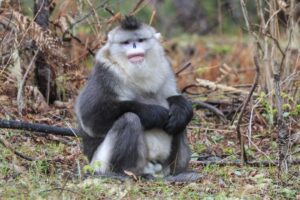
It’s a time of transformation and celebration. The monkeys have lost body weight, but their favorite food is growing again. Our cute baby monkey is now a year old. As grown up as she’s become, she still returns frequently to mom for milk and comfort. She won’t be fully weaned for another year when her mom gives birth again. And even then, they’ll likely stay close for a few more years. The cycle of life keeps turning. And the family continues to grow. The female who lost her baby last spring has a new arrival.
Already two weeks old, he’s healthy and strong. Our yearling girl is eager to introduce herself to her new little cousin. No longer the baby, she knows that in the future he’ll be a playmate and someone she can help care for. One day she’ll likely become a mother herself and continue the long line of these extraordinary monkeys. living in China’s hidden forest kingdom. Captioned by Side Door Media Service.


